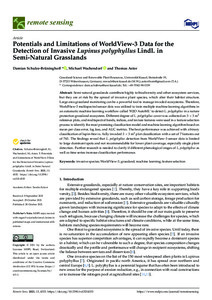| dc.date.accessioned | 2022-01-05T14:38:15Z | |
| dc.date.available | 2022-01-05T14:38:15Z | |
| dc.date.issued | 2021-10-28 | |
| dc.identifier | doi:10.17170/kobra-202112235346 | |
| dc.identifier.uri | http://hdl.handle.net/123456789/13489 | |
| dc.description.sponsorship | Gefördert durch den Publikationsfonds der Universität Kassel | ger |
| dc.language.iso | eng | eng |
| dc.rights | Namensnennung 4.0 International | * |
| dc.rights.uri | http://creativecommons.org/licenses/by/4.0/ | * |
| dc.subject | invasive species | eng |
| dc.subject | WorldView-3 | eng |
| dc.subject | grassland | eng |
| dc.subject | machine learning | eng |
| dc.subject | feature selection | eng |
| dc.subject.ddc | 600 | |
| dc.subject.ddc | 630 | |
| dc.title | Potentials and Limitations of WorldView-3 Data for the Detection of Invasive Lupinus polyphyllus Lindl. in Semi-Natural Grasslands | eng |
| dc.type | Aufsatz | |
| dcterms.abstract | Semi-natural grasslands contribute highly to biodiversity and other ecosystem services, but they are at risk by the spread of invasive plant species, which alter their habitat structure. Large area grassland monitoring can be a powerful tool to manage invaded ecosystems. Therefore, WorldView-3 multispectral sensor data was utilized to train multiple machine learning algorithms in an automatic machine learning workflow called ‘H2O AutoML’ to detect L. polyphyllus in a nature protection grassland ecosystem. Different degree of L. polyphyllus cover was collected on 3 × 3 m² reference plots, and multispectral bands, indices, and texture features were used in a feature selection process to identify the most promising classification model and machine learning algorithm based on mean per class error, log loss, and AUC metrics. The best performance was achieved with a binary classification of lupin-free vs. fully invaded 3 × 3 m² plot classification with a set of 7 features out of 763. The findings reveal that L. polyphyllus detection from WorldView-3 sensor data is limited to large dominant spots and not recommendable for lower plant coverage, especially single plant detection. Further research is needed to clarify if different phenological stages of L. polyphyllus as well as time series increase classification performance. | eng |
| dcterms.accessRights | open access | |
| dcterms.creator | Schulze-Brüninghoff, Damian | |
| dcterms.creator | Wachendorf, Michael | |
| dcterms.creator | Astor, Thomas | |
| dc.relation.doi | doi:10.3390/rs13214333 | |
| dc.subject.swd | Invasive Art | ger |
| dc.subject.swd | Vielblättrige Lupine | ger |
| dc.subject.swd | Grünland | ger |
| dc.subject.swd | Maschinelles Lernen | ger |
| dc.subject.swd | Sensor | ger |
| dc.subject.swd | Daten | ger |
| dc.type.version | publishedVersion | |
| dcterms.source.identifier | eissn:2072-4292 | |
| dcterms.source.issue | Issue 21 | |
| dcterms.source.journal | Remote Sensing | eng |
| dcterms.source.volume | Volume 13 | |
| kup.iskup | false | |
| dcterms.source.articlenumber | 4333 | |


